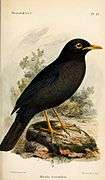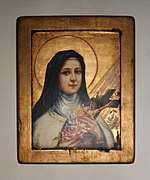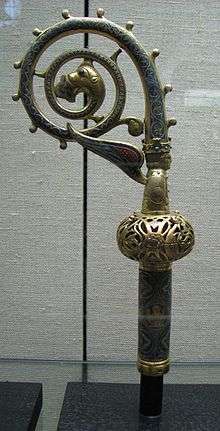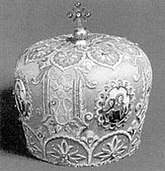Saint symbolism
Christianity has used symbolism from its very beginnings.[1] Each saint has a story and a reason why they led an exemplary life. Symbols have been used to tell these stories throughout the history of the Church.[2] A number of Christian saints are traditionally represented by a symbol or iconic motif associated with their life, termed an attribute or emblem, in order to identify them. The study of these forms part of iconography in art history.[3] They were particularly used so that the illiterate could recognize a scene, and to give each of the Saints something of a personality in art.[2] They are often carried in the hand by the Saint.

Attributes often vary with either time or geography, especially between Eastern Christianity and the West. Orthodox images more often contained inscriptions with the names of saints, so the Eastern repertoire of attributes is generally smaller than the Western. Many of the most prominent saints, like Saint Peter and Saint John the Evangelist can also be recognised by a distinctive facial type – as can Christ. In the case of later saints their actual historical appearance can also be used; Saint Bernardino of Siena (1380–1444) is one of the earliest whose distinctive appearance was well known from early prints and is nearly always used by artists. Some attributes are general, such as the palm frond carried by martyrs.[4] The use of a symbol in a work of art depicting a Saint reminds people who is being shown and of their story. The following is a list of some of these attributes.
Four Evangelists
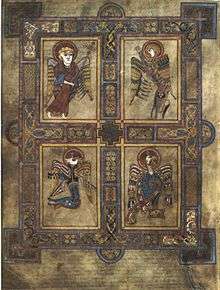
| Saint | Symbol[5] |
|---|---|
| Matthew | man or angel |
| Mark | winged lion |
| Luke | bull |
| John | eagle |
The Apostles
.jpg) The Synaxis of the Twelve Apostles. Russian, 14th century, Moscow Museum.
The Synaxis of the Twelve Apostles. Russian, 14th century, Moscow Museum.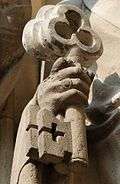 The key as symbol of St. Peter
The key as symbol of St. Peter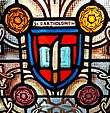 Stained glass window showing flaying knife, symbol of St. Bartholomew
Stained glass window showing flaying knife, symbol of St. Bartholomew.jpg) Scallop Shells, St. James the Great
Scallop Shells, St. James the Great
| Saint | Symbol |
|---|---|
| Andrew | saltire[a] |
| Bartholomew the Apostle | knife, human skin[a] |
| James, son of Zebedee | pilgrim's staff, scallop shell, key, sword, pilgrim's hat, astride a white charger, Cross of Saint James[a] |
| James, son of Alphaeus / James the Just | square rule, halberd, club, saw[a] |
| John | book, a serpent in a chalice, cauldron, eagle[a] |
| Jude | sword, square rule, club, ship[a] |
| Judas Iscariot | thirty pieces of silver[a] |
| Matthew | angel[a] |
| Peter | Keys of Heaven, boat, fish, rooster, pallium, papal vestments; man crucified head downwards on an inverted cross, vested as an Apostle, holding a book or scroll. Iconographically, he is depicted with a bushy white beard and white hair, and wearing a blue robe and yellow mantle.[a] |
| Philip | column; elderly bearded saint and open to God man, holding a basket of loaves and a Tau Cross[a] |
| Simon | boat; cross and saw; fish (or two fishes); lance; man being sawn in two longitudinally; oar[a] |
| Thomas | the twin, placing his finger in the side of Christ, axe, spear (means of martyrdom), square (his profession, a builder)[a] |
Mary, mother of Jesus
.jpg) The Immaculate Conception
The Immaculate Conception A traditional depiction of Mary by Fra Angelico wearing blue clothes
A traditional depiction of Mary by Fra Angelico wearing blue clothes
Mary is often portrayed wearing blue. Her attributes include a blue mantle, crown of 12 stars, pregnant woman, woman with child, woman trampling serpent, crescent moon, woman clothed with the sun, heart pierced by sword, Madonna lily, roses, and rosary beads.[6]
| Saint | Symbol |
|---|---|
| Our Lady of Sorrows | Mary in mournful state, tears, bleeding heart pierced by seven daggers[b] |
| Queen of Heaven | Mary with a crown of stars, flowers[a] |
Saints listed by name
A
| Saint | Symbol |
|---|---|
| Acathius of Melitene | crown of thorns[a] |
| Adalbert | spears[7] |
| Agatha of Sicily | tongs or shears, veil, bells, two breasts on a plate[a] |
| Agnes | lamb[a] |
| Alfege of Canterbury | axe[a] |
| Alfred the Great | codex, crown, orb/scepter[a] |
| Ambrose | bees, beehive, dove, ox, pen[a] |
| Anne, grandmother of Jesus | door, book[a], with the Virgin Mary reading, red robe and green mantle[8] |
| Anthony the Great | monk's habit, bell, pig, T-shaped cross[a] |
| Anthony of Padua | Child Jesus, bread, book, lily[a] |
| Athanasius of Alexandria | bishop arguing with a pagan, bishop holding an open book, bishop standing over a defeated heretic[a] |
| Augustine of Hippo | dove, child, shell, pen, book[a] |
B
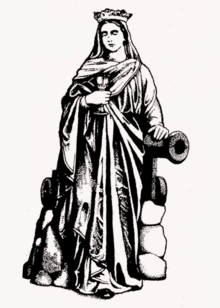
 Olive branch
Olive branch priest celebrating Mass on board a ship while fish gather to listen
priest celebrating Mass on board a ship while fish gather to listen
| Saint | Symbol |
|---|---|
| Barbara | tower, chalice, ciborium, cannon[a] |
| Barnabas | pilgrim's staff, olive branch[a] |
| Benedict | broken cup, raven, bell, crosier, bush[a] |
| Benno of Meissen | fish with keys in its mouth, book[a] |
| Bernard of Clairvaux | pen, bees, instruments of the Passion[a] |
| Bernardino of Siena | tablet or sun inscribed with IHS, three mitres[a] |
| Blaise | wax, taper (candle), iron comb[a] |
| Bonaventure | communion, ciborium, cardinal's hat[a] |
| Boniface | oak, axe, book, fox, scourge, fountain, raven, sword[a] |
| Brendan the Navigator | whale; priest celebrating Mass on board a ship while fish gather to listen; one of a group of monks in a small boat [a] |
| Bridget of Sweden | book, pilgrim's staff[a] |
| Brigid of Kildare | cow, crosier, Brigid's cross[a] |
C
 The college shield of St Catharine's College, Cambridge, prominently depicting a Catherine wheel.
The college shield of St Catharine's College, Cambridge, prominently depicting a Catherine wheel.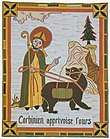 Corbinian with saddled bear
Corbinian with saddled bear
| Saint | Symbol |
|---|---|
| Casimir of Poland and Lithuania | royal attire of crown and red robe lined with ermine, lily, cross, rosary; sometimes two right hands[a] |
| Catherine of Alexandria | wheel, crown, sword, book[a] |
| Catherine of Ricci | ring, crown, crucifix[a] |
| Catherine of Siena | stigmata, cross, ring, lily[a] |
| Cecilia | organ[a] |
| Cerbonius | geese[a] |
| Charles Borromeo | cardinal's robes, communion[a] |
| Christopher | giant crudely dressed, torrent, tree, branch or large staff, carrying the Child Jesus on shoulder[a] |
| Clare of Assisi | monstrance[a] |
| Clare of Montefalco | cross[a] |
| Clement | anchor, fish,[a] Mariner's Cross[b] |
| Corbinian | saddled bear{[9] |
| Saints Cosmas and Damian | a phial, box of ointment[a] |
| Saints Crispin and Crispinian | shoes, millstones[a] |
| Cyriacus | deacon's vestments[a] |
D
- Man with lions
 Dog with a torch
Dog with a torch.jpg) Dorothy with flowers and apples
Dorothy with flowers and apples
| Saint | Symbol |
|---|---|
| Daniel | lion[a] |
| David of Scotland | king with sword or sceptre[a] |
| David of Wales | dove[a] |
| Demetrius | Depicted wearing the armor of a Roman soldier, usually carrying a spear, often seated on a red horse[a] |
| Denis | head in hands[a] |
| Dominic | rosary[a] , star, dog with a torch[10] |
| Dominic de la Calzada | hen and rooster, monastic habit, prayer beads, shepherd's crook[b] |
| Dorothea of Caesarea | flowers, fruits[11] |
| Dunstan | hammer, tongs[a] |
| Dymphna | crown, sword, lily, lamp, princess with a fettered devil at her feet[a] |
E
| Saint | Symbol |
|---|---|
| Earconwald | bishop travelling in a chariot[a] |
| Edmund the Martyr | quiver of arrows[a] |
| Edward the Confessor | king crowned with a nimbus and holding a sceptre[a] |
| Saint Eligius | bishop portrayed with a crosier in his right hand, on the open palm of his left a miniature church of chased gold; with a hammer, anvil, and horseshoe; or with a horse[a] |
| Elijah | cave[a] |
| Elisabeth of Hungary | alms, flowers, bread, the poor, pitcher[a] |
| Emeric | sword, lily[7] |
| Emilianus | monk on horseback[a] |
| Elizabeth of Aragon | crown[a] |
| Erasmus of Formiae | windlass[a] |
| Eric of Sweden | king being martyred at Mass[a] |
| Eustace | hunting clothes, stag, bull, crucifix, horn, oven[a] |
F

.jpg) Crab with crucifix
Crab with crucifix Cross of Saint Florian
Cross of Saint Florian
| Saint | Symbol |
|---|---|
| Faith | Shield of the Trinity[a] |
| Felix of Burgundy | anchor[a] |
| Fiacre | spade, basket of vegetables[a] |
| Florian | Cross of Saint Florian; Roman officer or soldier; pitcher of water; pouring water over fire[12] |
| Florinus of Remüs | bottle, glass of wine[a] |
| Fourteen Holy Helpers | Saints Acacius, Barbara, Blaise, Christopher, Cyriacus, Catherine of Alexandria, Denis, Erasmus of Formiae, Eustace, George, Giles, Margaret of Antioch, Pantaleon, and Vitus, shown as a group.[b] |
| Francis of Assisi | wolf, birds, fish, skull, stigmata[a] |
| Francis Xavier | crucifix, bell, vessel, crab with a cross[a] |
G
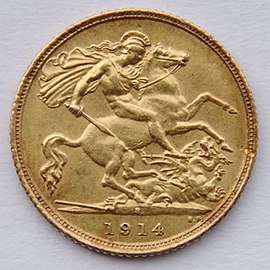
 Archangel with lily
Archangel with lily.jpg) Man with theatrical mask
Man with theatrical mask
| Saint | Symbol |
|---|---|
| Gabriel | Archangel;[13] Clothed in blue or white garments; Carrying a lily,[14] a trumpet, a shining lantern, a branch from Paradise, a scroll,[14] and a scepter.[14], scroll stating "Ave Maria Gratia Plena"[15][a] |
| Gall | an abbot blessing a bear that brings him a log of wood; may be shown holding a hermit's tau staff with the bear or carrying a loaf and a pilgrim's staff.<[16] |
| Genesius | theatre mask[a] |
| Genevieve | lit candle, bread, keys, herd, cattle[a] |
| George | dragon, soldier or knight in armour, often on white horse, especially in the East, Cross of Saint George[a] |
| Gerard of Csanád | Bishop being killed by a spear[a] |
| Gertrude of Nivelles | crown, tapir, lily, mouse[a] |
| Gervasius and Protasius | the scourge, the club and the sword[b] |
| Giles | Benedictine habit, hind[a] |
| Godelieve | crown, well, woman being strangled[b] |
| Gotthard of Hildesheim | dragon; model of a church[17] |
| Gregory the Great | papal tiara, crosier, dove (often portrayed at his ear)[a] |
H
- Man with baker's peel
 A "fiddleback" chasuble from the church of Saint Gertrude in Maarheeze in the Netherlands
A "fiddleback" chasuble from the church of Saint Gertrude in Maarheeze in the Netherlands
| Saint | Symbol |
|---|---|
| Helena | wearing a royal crown while supporting a cross[a] |
| Hermann Joseph | kneeling before a statue of the Virgin and Child and offering an apple[a] |
| Hermenegild | axe, crown, sword, and cross [b] |
| Hilary of Poitiers | episcopal vestments, a mitre and crozier, and a beard, usually white and often long[b] |
| Hippolytus of Rome | papal tiara[a] |
| Hippolytus the soldier | military garb, horse's harness[a] |
| Honoratus of Amiens | baker's peel or shovel; bishop with a large Host; bishop with three Hosts on a baker's shovel; loaves[a] |
| Hugh of Lincoln | swan[a] |
| Humility | dressed as a nun [a] |
| Hyacinth of Poland | statue of the Blessed Virgin Mary; Monstrance or Ciborium [b] |
I
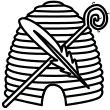 Symbol for Isidore of Seville: beehive, crozier and quill
Symbol for Isidore of Seville: beehive, crozier and quill.jpg)
 IHS monogram of the name of Jesus
IHS monogram of the name of Jesus
| Saint | Symbol |
|---|---|
| Ignatius of Antioch | a bishop surrounded by lions or in chains[a] |
| Ignatius of Loyola | Eucharist, chasuble with Jesuit-style collar, book often inscribed with "Ad majorem Dei gloriam", or the letters AMDG, the letters "ihs" with a cross across the h (traditionally with three nails below the letters, and the letters and nails surrounded by the sun's rays), sword, cross.[a] |
| Imerius of Immertal | hermit's garb and bird of prey[a] |
| Irene of Tomar | palm of martyrdom[a] |
| Isaiah | An old man with gray hair and beard holding a scroll with words from Isaiah 7:14, (in Latin) ecce virgo concipiet et pariet filium et vocabitur nomen eius Emmanuel, "behold, a virgin shall conceive and bear a son, and his name shall be Emmanuel[b] |
| Isidore the Laborer | Portrayed as a peasant holding a sickle and a sheaf of corn, a sickle and staff; as an angel plows for him; or with an angel and white oxen near him. In Spanish art, his emblems are a spade or a plough.[18] |
| Isidore of Seville | bees, pen, book[a] |
| Ivo of Kermartin | depicted as a lawyer, holding a document, in legal dress.[a] |
J
 An axe, the symbol of the martyrdom of Judas Thaddeus and other saints
An axe, the symbol of the martyrdom of Judas Thaddeus and other saints Juan Diego, wearing a tilmàtli
Juan Diego, wearing a tilmàtli
| Saint | Symbol |
|---|---|
| Jerome | lion, cardinal clothing, cross, skull, books and writing material, stone in hand[a] |
| Joan of Arc | shield, Cross of Lorraine[a] |
| Saint Joanna | lamb[a] |
| John Berchmans | Rule of Saint Ignatius, cross, rosary[a] |
| John Chrysostom | bees, dove, pen[a] |
| John of God | alms, heart, crown of thorns[a] |
| John the Baptist | lamb, head on a platter, animal skin (the camel-skin coat of the Gospels), pointing at Christ or a lamb, often portrayed carrying a long crudely made cross[a] |
| Joseph of Anchieta | Gospel book, crucifix and Walking stick[a] |
| Joseph, spouse of Mary | Child Jesus, lily, rod, plane, carpentry square, purple robe and brown mantle[a] |
| Juan Diego | tilmàtli[a] |
| Justin Martyr | axe, sword[a] |
| Justina of Padua | palm frond, knife, unicorn[a] |
| Juthwara | round soft cheese[a] |
K
| Saint | Symbol |
|---|---|
| Kateri Tekakwitha | turtle, lily[a][b] |
| Katharine Drexel | woman dressed as a nun[a] |
| Kentigern | bishop with a robin on his shoulder; holding a bell and a fish with a ring in its mouth[19] |
| Kevin of Glendalough | blackbird[a] |
| Kilian | wearing a bishop's mitre and wielding a sword[a] |
| Kinga of Poland | depicted as an abbess; crown[a] |
| Kjeld of Viborg | Priest with book[a] |
| Knut of Denmark | Nordic king with royal insignia, dagger, lance or arrow.[a] |
| Koloman | pilgrim monk with a rope in his hand; depicted being hanged on a gibbet; tongs and rod; priest with a book and maniple[b] |
L
.jpg)
 Eyes on a plate
Eyes on a plate
| Saint | Symbol |
|---|---|
| Lambert of Maastricht | palm of martyrdom[a], sword[b] |
| Lawrence of Rome | cross, Gospel Book, gridiron, palm frond, purse of money, attired as a deacon in a dalmatic, accompanied by a group of poor people.[b] |
| Leander of Seville | pen[a] |
| Leonard of Noblac | lock, chain, manacles or fetters[b] |
| Liborius of Le Mans | pebbles, peacock[b] |
| Longinus | Military attire, lance[b] |
| Louis IX of France | royal attire of crown and blue robe decorated with golden fleur-de-lis, crown of thorns, nails[b] |
| Louis Bertrand | a chalice containing a snake [b] |
| Louis of Toulouse | silk gloves and a richly embroidered cape with a jeweled clasp at the neck[b] |
| Lucy | cord, eyes on a dish, lamp[a] |
M
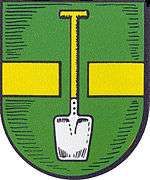
- Red egg
| Saint | Symbol |
|---|---|
| Margaret of Scotland | reading[a] |
| Margaret the Virgin | dragon in chains[a] |
| Maria Goretti | fourteen lilies; farmer's clothing; (occasionally) a knife[a] |
| Martha | aspergillum, dragon[a] |
| Martin of Tours | goose; sharing cloak with beggar[a] |
| Martin de Porres | broom, a cat, dog and a mouse eating from the same plate[7] |
| Mary Magdalene | jar of ointment, red egg[a] |
| Matilda | purse, alms[a] |
| Maurice | soldier in armour, banner with red cross[a] |
| Maurus | scales, spade, crutch[a] |
| Menas of Crete | two camels[a] |
| Michael | scales, banner, sword, dragon[a] |
| Monica | girdle, tears[a] |
N

 Rooster atop St Nicholas church
Rooster atop St Nicholas church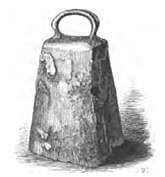
| Saint | Symbol |
|---|---|
| Neot | fish[a] |
| Nicholas | three purses or balls, anchor, boat, child[a] |
| Nicholas of Tolentino | Augustinian holding a bird on a plate in the right hand and a crucifix on the other hand; holding a basket of bread, giving bread to a sick person; holding a lily or a crucifix garlanded with lilies; with a star above him or on his breast[b] |
| Nicolás Factor | Franciscan habit, skull, fire [b] |
| Pope Nicholas I | rooster[20] |
| Ninian | Clogrinny, or the Bell of St. Ninian[a] |
| Norbert of Xanten | monstrance, cross with two beams[a] |
O
 king with axe in a viking boat
king with axe in a viking boat- Woman with larkspur
| Saint | Symbol |
|---|---|
| Obadiah | Prophet with his index finger of his right hand pointing upward[b] |
| Oda of Scotland | depicted wearing a long blue gown with one shoulder bare; usually carries a staff or a book; always shown with a magpie on her hand and a crown under her feet[a] |
| Odile of Alsace | Abbess praying before an altar; woman with a book on which lie two eyes; larkspur[b] |
| Olaf of Norway | axe in Norway's coat of arms, king with axe in a Viking boat[a] |
| Onuphrius | old hermit dressed only in long hair and a loincloth of leaves; hermit with an angel bringing him the Eucharist or bread; hermit with a crown at his feet |
| Opportuna of Montreuil | depicted carrying an abbess's crozier and a casket of relics. She may also be shown with the Virgin appearing at her deathbed or as a princess with a basket of cherries and a fleur-de-lys[21] |
| Osgyth | represented in art with a stag behind her and a long key hanging from her girdle, or otherwise carrying a key and a sword crossed, a device which commemorates St. Peter, St. Paul and St. Andrew[22] |
P
 Baptismal font in Magdeburg Cathedral
Baptismal font in Magdeburg Cathedral
| Saint | Symbol |
|---|---|
| Pancras | sword, palm branch[a] |
| Pantaleon | nailed hands[a] |
| Patrick | cross, harp, serpent, baptismal font, demons, shamrock[a] |
| Paul the Apostle | sword, book or scroll, horse; long, pointed beard, and balding backwards from forehead. Green robe, red mantle.[a] |
| Peter of Saint Joseph de Betancur | Bell, Franciscan habit and spear canary pastor.[a] |
| Saint Peter of Verona | Dominican with a hatchet in his head or a severe head wound; or writing the words "Credo in unum Deum" as he dies[a] |
| Petronilla | set of keys, dolphin[a] |
| Philip Neri | lily[a] |
| Philomena | anchor, palm, arrows[a] |
Q
- Young man with two spits
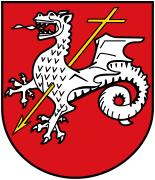 The arms of Roetgen showing the symbol of Quirinus, the patron saint of Rott, who killed a dragon with a crossed-spear
The arms of Roetgen showing the symbol of Quirinus, the patron saint of Rott, who killed a dragon with a crossed-spear
| Saint | Symbol |
|---|---|
| Quentin | depicted as a young man with two spits; as a deacon; with a broken wheel; with a chair to which he is transfixed; with a sword; or beheaded, a dove flying from his severed head[a] |
| Quiricus | depicted as a naked child riding on a wild boar[a] |
| Quirinus of Malmedy | dragon[23] |
| Quirinus of Neuss | military attire; knight with lance, sword, hawk; banner or sign with nine balls[a] |
| Quirinus of Sescia | millstone hanging from his neck[b] |
| Quiteria | depicted with a dog on a lead; depicted with her head in her hands, emerging from the sea.[a] |
R
 dog with bread, leg wound
dog with bread, leg wound- Forehead wound
| Saint | Symbol |
|---|---|
| Raphael | fish[b] |
| Raymond Nonnatus | A Mercedarian friar wearing a cardinal's red mozzetta, holding a monstrance and a martyr's palm branch [b] |
| Raymond of Penyafort | skimming across the sea with his cape as both boat and sail[b] |
| Remigius | dove, book, lamp[b] |
| Reparata | Standing alone or near St. Mary, bearing a martyr's crown and palm; a dove; a banner with a red cross on a white field; sometimes depicted with St. Ansanus[24] |
| Richard | bishop with overturned chalice[a] |
| Rita of Cascia | roses, roses and figs, crucifix, thorn, sometimes with a wound in her forehead[a] |
| Roch | angel, dog with bread, leg wound, pilgrim's dress[a] |
| Rosalia of Palermo | Depicted as a young woman, sometimes holding a cross, book, or skull, and also a spray of lilies[b] |
| Rose of Lima | crown of thorns, anchor, city, roses, crown of roses[a] |
| Rufina and Justa | A model of the Giralda; earthenware pots, bowls and platters; books on which are two lumps of potter's clay; palm of martyrdom; lion[b] |
S
 St. Stephen the Martyr depicted with three stones and the martyr's palm
St. Stephen the Martyr depicted with three stones and the martyr's palm Fiery furnace
Fiery furnace
| Saint | Symbol |
|---|---|
| Sativola | scythe, well[a] |
| Sava of Serbia | book[a] |
| Sebastian | arrows, crown[a] |
| Shadrach, Meshach, and Abednego | fiery furnace[b] |
| Spyridon of Corfu | bishop with Gospel; long, pointed beard, and wearing a shepherd's hat[a] |
| Stanislaus of Szczepanów | sword[a] |
| Stanisław Kazimierczyk | Priest's attire[a] |
| Stephen the Martyr | stone(s)[a] |
| Stephen of Hungary | royal attire of crown and robes, and holding orb or sceptre with double cross[7] |
| Swithun | bishop with bridge, broken eggs[a] |
T
| Saint | Symbol |
|---|---|
| Teresa of Ávila | heart, arrow, look[a] |
| Teresa of the Andes | small cross, flowers[a] |
| Theodore | crocodile[a] |
| Thérèse de Lisieux | roses entwining a crucifix[a] |
| Thomas Aquinas | monstrance, dove, ox[a] |
| Thomas Becket | sword, and wearing chancellor's robe and neck chain[a] |
| Thomas More | axe[a] |
| Timothy | three stones and a clubclub and stones; broken image of Diana[25] |
| Trudpert | axe[a] |
| Tudwal | dragon[a] |
U
 Bishop with grapes
Bishop with grapes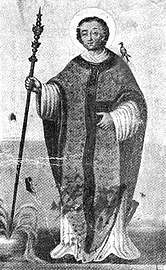 birds on his shoulder; wearing fur pelisse in a religious habit
birds on his shoulder; wearing fur pelisse in a religious habit
| Saint | Symbol |
|---|---|
| Ulrich of Augsburg | Bishop holding a fish; at dinner with Saint Wolfgang; rewarding a messenger with a goose leg, which turns into a fish on Friday morning; giving a garment to a beggar; with Saint Afra; riding through a river on horseback as his companion sinks; with a cross given him by an angel[b] |
| Urban | portrayed in art after his beheading, with the papal tiara near him[a] |
| Urban of Langres | bishop with a bunch of grapes or a vine at his side; a book with a wine vessel on it[a] |
| Ursicinus | book and fleur-de-lis[a] |
| Ursula | arrow; banner; cloak; clock; maiden shot with arrows; depicted accompanied by a varied number of companions who are being martyred in various ways; ship[a] |
| Ursus of Aosta | birds on his shoulder; wearing fur pelisse in a religious habit[a] |
V
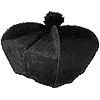 A traditional biretta
A traditional biretta.jpg) The Veil of Veronica
The Veil of Veronica
| Saint | Symbol |
|---|---|
| Valentine | Birds; roses; bishop with a crippled person or a child with epilepsy at his feet; bishop with a rooster nearby; bishop refusing to adore an idol; bishop being beheaded; priest bearing a sword; priest holding a sun; priest giving sight to a blind girl[26] |
| Vedast | wolf carrying a goose in its mouth; child; bear[a] |
| Venera | crown; book; palm; cross; a palm of martyrdom interlaced with a triple crown (signifying the fact that she was a Virgin, an Apostle, and a Martyr{[b] |
| Verdiana | snakes[a] |
| Veronica | Veil of Veronica[a] |
| Victor of Marseilles | windmill[a] |
| Vigilius of Trent | shoes or clogs[a] |
| Vincent de Paul | children[a] |
| Vincent Ferrer | pulpit, cardinal's hat, trumpet, captives[a] |
| Vitus | cross, rooster, lion[a] |
W
| Saint | Symbol |
|---|---|
| Wenceslaus of Bohemia | crown, dagger[a] |
| William of Montevergine | wolf and pastoral crook[a] |
| William of York | bishop crossing the River Tweed[a] |
| Winnoc | hand-mill, bridge, grinding corn[a] |
| Wolfgang of Regensburg | a church building with an adze lodged in the roof, a wolf[a] |
X
 Walking stick
Walking stick
| Saint | Symbol |
|---|---|
| Xenia of Saint Petersburg | walking stick[a] |
| Xystus | book, papal tiara, martyr's palm[a] |
Z
- flowering tree; bringing a dead man or child back to life
| Saint | Symbol |
|---|---|
| Zachary | Making peace with King Luitprand. Sometimes he may have an olive branch and a dove over him [a] |
| Zenobius of Florence | flowering tree; bringing a dead man or child back to life[a] |
| Zita | bag, keys[a] |
Plants in symbolism

.jpg) Blue passion flower (P. caerulea) showing most elements of the Christian symbolism
Blue passion flower (P. caerulea) showing most elements of the Christian symbolism
| Flower | Symbol | Reason |
|---|---|---|
| Acacia | A symbol of the immortality of the soul | durability of the wood [d] |
| Almond | A symbol of divine approval | From the Book of Numbers "The next day Moses entered the Tent of the Testimony and saw that Aaron's staff, which represented the house of Levi, had not only sprouted but had budded, blossomed and produced almonds." [d][27] |
| Anemone | crucifixion scenes and have been associated with the sorrow of Virgin Mary | these flowers grew at Golgotha[c] |
| Columbine | Holy Spirit | The name "columbine" comes from the Latin for "dove", due to the resemblance of the inverted flower to five doves clustered together.[28][c] |
| Daisy | innocence, beauty, salvation, modesty, purity and love | simplicity[c] |
| Hyacinth | prudence, constancy, desire of heaven and peace of mind | From the story of Hyacinthus, upon whose death the flower sprung forth.[29] |
| Iris | Our Lady of Sorrows | sharp leaves like swords [c] |
| Lily | virtues of justice, charity and hope; also the Holy Trinity, the Madonna lily is specific to Mary | lilies with three petals [c] |
| Palm branch | Martyrdom | symbol of victory in that war waged by the spirit against the flesh |
| Passionflower | Crucifixion of Jesus | each part of the flower represents a different aspect of the Passion of Christ [c] |
| Rose | Mary | queen of flowers [c][30] |
| White clover | Holy Trinity | Three petals that compose a flower [c] |
| White tulip | Holy Spirit | White tulips are used to send a message of forgiveness[31] |
Further reading
- Delaney, John P. (1980). Dictionary of Saints (Second ed.). Garden City, NY: Doubleday. ISBN 0-385-13594-7.
- Lanzi, Fernando; Lanzi, Gioia (2004-09-01). Saints and their Symbols: Recognizing Saints in Art and in Popular Images. Translated by O'Connell, Matthew J. ISBN 9780814629703.
- Post, W. Ellwood (1975). Saints, Signs and Symbols (2 ed.). SPCK Publishing. ISBN 9780281028948.
- Schiller, Gertrud (1971). Iconography of Christian Art. 1. ISBN 978-0821203651.
- Walsh, Michael (2007). A New Dictionary of Saints: East and West. Liturgical Press. ISBN 978-0-8146-3186-7.
- Whittemore, Carroll E. (1980). Symbols of the Church. Abingdon Press. ISBN 0687183014.
See also
- Calendar of saints
- Christian symbolism
- Christianization of saints and feasts
- Doctor of the Church
- Iconography
- List of canonizations, for a list of Catholic canonizations by date
- Martyrology
- Patron saint
- Weather saints
External links
- "Christian Iconography". Augusta State University. Archived from the original on 2014-03-18.CS1 maint: BOT: original-url status unknown (link)
- "Hagiographies, hymnography, and icons for many Orthodox saints". Orthodox Church in America.
- "Catholic Forum Patron Saints Index". Archived from the original on 2005-05-31.
- "Saints' Badges or Shields".
- "On the Canonizations of John Paul II". Archived from the original on 2007-09-28.
Notes
- "List of saints". Catholic Online.
- "Iconography". Christian Iconography. 2015-10-20.
- Kostka, Arun Oswin. "Flowers in Christian Symbolism".
- Gast, Walter E. (2000). "Symbols in Christian Art and Architecture".
References
-

- Mayernik, David T. (2018). "A Vast, Immeasurable Sanctuary: Iconography for Churches". Sacred Architecture Journal. 5: 22.
- "Eastern Orthodox and Catholic teaching about Icons".
- Hassett, M. (1911). "Palm in Christian Symbolism". The Catholic Encyclopedia.
- Saint Jerome; St. Jerome (December 2008). Commentary on Matthew (The Fathers of the Church, Volume 117). CUA Press. p. 55. ISBN 978-0-8132-0117-7.
- Kugeares, Sophia Manoulian (1991). Images Of The Annunciation Of The Virgin Mary Of The 13th, 14th And 15th Century.
- Stracke, Richard (2015-10-20). "Hungarian Saints: Adalbert, Martin, Stanislas, Emeric and Stephen". Christian Iconography.
- Fongemie, Pauly. "SYMBOLS IN ART". Catholic tradition. Retrieved 2019-01-15.
- "L'Osservatore Romano publishes new Papal coat of arms". Catholic News Agency. 2005-04-28. Retrieved 2007-01-05.
- Libellus de principiis, citing the story of his birth
- "Saint Dorothy of Caesarea". Patron Saints Index. 2008-03-18. Archived from the original on 2008-03-18.
- Mendler, Mitch. "Saint Florian - the patron saint of the fire service". Retrieved 2019-01-16.
- Zimmerman, Julie. "Friar Jack's Catechism Quiz: Test Your Knowledge on Angels". AmericanCatholic.org. Archived from the original on 21 May 2012. Retrieved 16 February 2012.
- Ronner, John (March 1993). Know Your Angels: The Angel Almanac With Biographies of 100 Prominent Angels in Legend & Folklore-And Much More!. Murfreesboro, TN: Mamre Press. pp. 70–72, 73. ISBN 9780932945402. LCCN 93020336. OCLC 27726648. Retrieved 2013-11-15.
Artists like to show Gabriel carrying a lily (Mary's flower), a scroll and a scepter.
- OrthodoxWiki. "Archangel Gabriel" (Internet). OrthodoxWiki. Retrieved 2013-11-15.
Because the Angels are incorporeal beings, though they nevertheless take on human form when appearing to mankind, it can be difficult to differentiate one from another in icons. However, Gabriel is usually portrayed with certain distinguishing characteristics. He typically wears blue or white garments; he holds either a lily (representing the Theotokos), a trumpet, a shining lantern, a branch from Paradise presented to him by the Theotokos, or a spear in his right hand and often a mirror—made of jasper and with a Χ (the first letter of Christ (Χριστος) in Greek)—in his left hand. He should not be confused with the Archangel Michael, who carries a sword, shield, date-tree branch, and in the other hand a spear, white banner (possibly with scarlet cross) and tends to wear red. Michael's specific mission is to suppress enemies of the true Church (hence the military theme), while Gabriel's is to announce mankind's salvation.
- "Saint of the Day, October 16". St. Patrick Catholic Church. Retrieved 2012-03-08.
- "Godehard (Gotthard) von Hildesheim". Ökumenisches Heiligenlexikon (in German). Retrieved 2019-01-15.
- d, d. "Isidore and Maria, Patron Saints of Farmers". d. National Catholic Rural Life Conference. Archived from the original on 2013-04-06. Retrieved 2013-04-06.
- "Saint Kentigern". Saints.sqpn.com. Archived from the original on 6 March 2012. Retrieved 14 November 2012.
- Adler, Jerry; Lawler, Andrew. "How the Chicken Conquered the World". Smithsonian. Smithsonian Institution. Retrieved 2012-06-01.
- Rabenstein, Katherine (April 1999). "Opportuna of Montreuil, OSB". Saints O' the Day for April 22. Archived from the original on February 6, 2007. Retrieved 2012-02-24.CS1 maint: unfit url (link)
- "Lives". Britannia.com.
- Baring-Gould, Sabine (1898). "The Lives of the Saints". The Lives of the Saints.
- Jameson, Anna (1857). Sacred and Legendary Art. Longman, Brown, Green. p. 648.
- "Saints Timothy & Titus", Saints, Passionist nun.
- Jones, Terry. "Valentine of Terni". Patron Saints Tom. Archived from the original on April 1, 2010. Retrieved February 14, 2007.
- Numbers 17:1-8
- Shorter Oxford English dictionary, 6th ed. United Kingdom: Oxford University Press. 2007. p. 3804. ISBN 978-0199206872.
- "Signs and Symbols". catholictradition.org. Retrieved 2019-01-22.
- Cucciniello, Lisa (2008). Rose to Rosary: The Flower of Venus in Catholicism. Rose Lore: Essays in Semiotics and Cultural History. Lexington Books. pp. 64–65.
- "Easter Flowers". flowermeaning.com. Archived from the original on 2018-03-10. Retrieved 2018-03-10.




